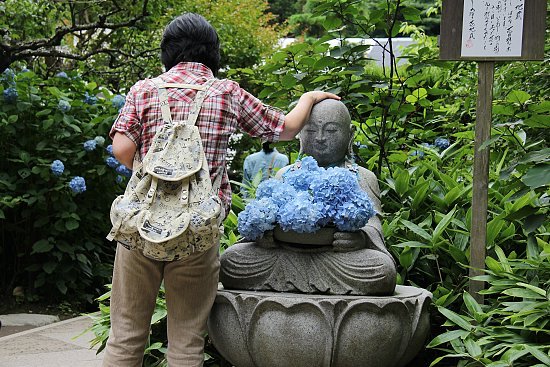Hydrangea Flowers in Kamakura
by Sean, staff writer of japan-guide.com
| previous post |
| next post |
2012/06/18 - Hydrangea Flowers in Kamakura

Let's take this opportunity to wish all fathers a belated Happy Father's Day. Today we made a trip to Kamakura to check out the hydrangea. Hydrangea are called Ajisai in Japanese, and they remind most Japanese people of the rainy season, around the month of June. This is because hydrangea bloom at about the same time, and the flowers grow deeper in color as rain water falls on them through this period.

Tokeiji Temple
Our first stop was at Tokeiji Temple, also nicknamed the "Divorce Temple": in the past, women in Japan were not allowed to initiate a divorce from their husbands. The temple served as a sanctuary for such women and there was a rule that if a woman stayed at Tokeiji for three years, her marriage could be annulled.
Since the late 19th century however, with new women rights written into law, such a function of the temple is no longer necessary. Today many women were here, not to escape from their husbands, but to appreciate the beautiful hydrangea in full bloom. The flowers blossomed in plump, chubby, rounded bunches, of different colors as white, pink, purple and blue.



Meigetsuin
Meigetsuin is known for its temple grounds and garden which have different seasonal flowers on display all year round. At this time of the year, the main flowers in bloom are hydrangea and irises. 95% of the hydrangea here are "Hime Ajisai", which means "Princess Hydrangea" in English. They were thus named because of their sweet colors: being light blue at first, the pretty bunches brighten and then become more intense in color with each occurrence of rain till they become violet-blue, and later dark blue.
On this visit, I found out why Meigetsuin is also known as "Ajisaidera", meaning "Hydrangea Temple": they were everywhere! The several paths of the temple, especially that of the stone steps leading to the temple's main buildings, were so fully lined with Princess Hydrangea (as well as people), that on many occasions I had to apologetically brush my shoulders against them - as gently as possible lest I should cause any distress to her royal highnesses.
A separate fee is required to enter the inner garden, whereby irises can be viewed currently.





Hasedera Temple

We took a hiking course through the woods to get to Hasedera Temple, one of the most visited temples in Kamakura. The temple houses a huge statue of Kannon the goddess of mercy, and has an observation platform from which good views of the city of Kamakura can be seen. At this time of the year, it also becomes a popular spot to view hydrangea.
It was more popular than we had expected. We arrived at the temple at about two and found it to be flooded by armies of visitors. Looking up the hill behind the temple buildings, where the hydrangea are planted, I could see a long queue which stretched upwards till it faded from view in the midst of the plants and the trees.
There was a system of lining up, whereby numbers were issued to visitors, indicating how long they would have to expect to wait. Regrettably, we didn't have the estimated 75 minutes to spare, and had to leave without going up the hill. Judging by the number of hydrangea there were at the bottom of the hill, and by the number of people who were willing to queue to go up, I think it might well be worth the time should you be interested to visit and have an hour or two to spare.




| previous post |
| next post |


